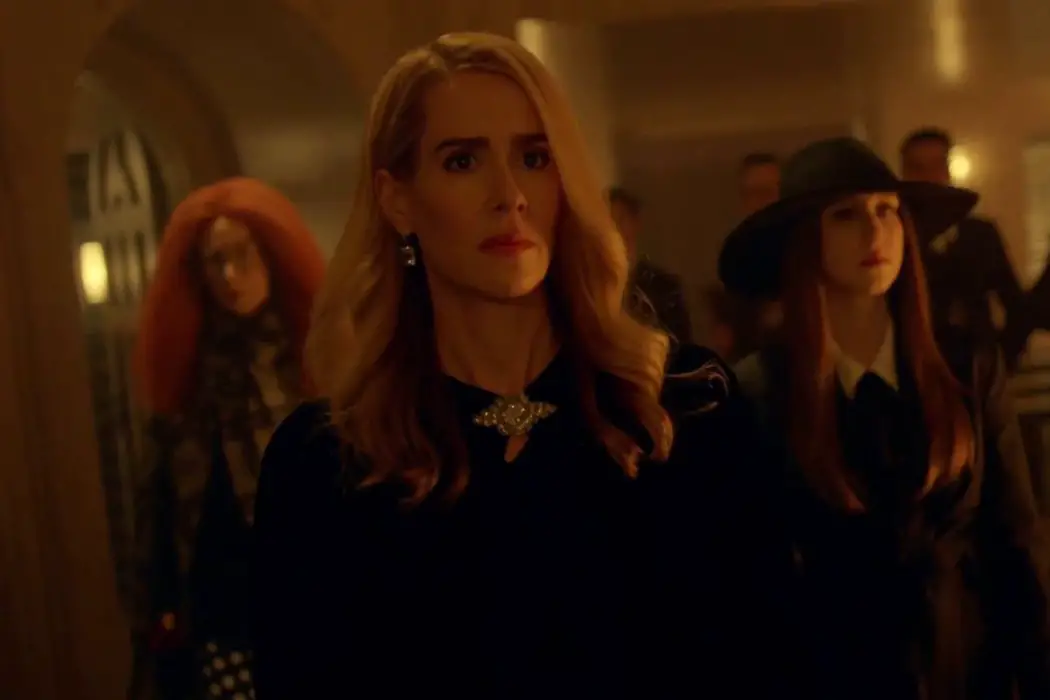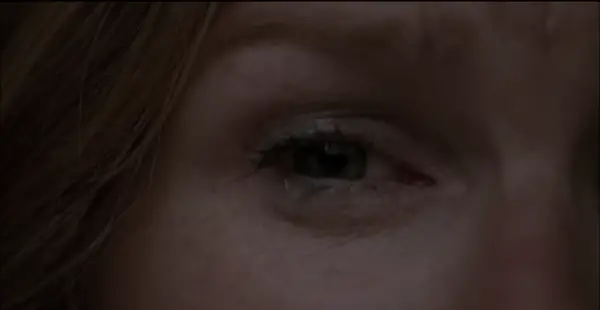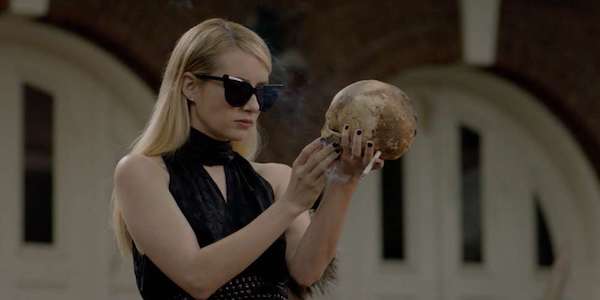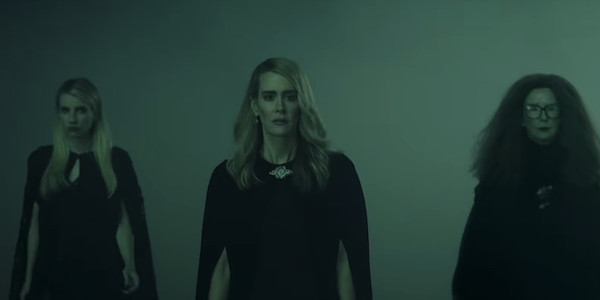Witches At World’s End In AMERICAN HORROR STORY: APOCALYPSE

Michael Colbert is a writer based in Portland, Maine. He…
Old ghosts have a lot to say about the end of the world. American Horror Story’s eighth season “Apocalypse” resurrects a host of characters, spinning an intertextual web as actors like Sarah Paulson, Evan Peters, and Taissa Farmiga play multiple characters, at times in the same episode.
The show has operated in genre nods since its inception. From musical references to Carrie and Candyman to narrative arcs and imagery that summon Rosemary’s Baby and Carmilla. In its eighth season, American Horror Story pulls together the threads that have sometimes come unspun to tell the story of the end of the world, a story that began in the show’s first season. And what better way to inspect the ending than through the lenses of the witches from “Coven,” a season that lends the apocalypse a certain degree of campiness but also cashes in on the cultural moment of witchiness.
The season begins with the apocalypse, and characters move to an underground bunker. But soon, all those characters die, seemingly expendable as it is, after all, the apocalypse. They die at the hands of Michael Langdon, the lusciously locked and fully-grown version of the baby born to Vivien Harmon in “Murder House,” the show’s first season.
“Murder House” reexamines Roman Polanski’s Rosemary’s Baby – a film whose satanic rape scene is made even less savory in light of Polanski’s history of sexual violence against women. The arrival of Michael Langdon on screen extends the horrors of the antichrist beyond the pregnancy of his mother and into his transgressions in life as well.
American Horror Story has referenced previous seasons throughout the show but has scarcely included “Murder House.” Calling forth old ghosts today cuts open their retelling of Rosemary’s Baby in 2018 and considers what else is to be said. The show explores how these events precipitated, looking at men and women in power. The lens of horror, though, allows the show to subvert and confront our expectations. It asks, what went wrong and how we got to this place. It goes back to the show’s roots to learn more.
Rosemary, Revisited
The Harmon family moves into their Los Angeles home to bring their family back together. Vivien (Connie Britton) and her husband Ben have sex shortly after moving in when he walks in on her removing gaudy wallpaper from the walls, unveiling hellish paintings and condemnation.
That same night Vivien has sex with another man in a rubber suit, a man she believes to be her husband but does not realize is a ghost. The demonic sex scene summons Rosemary’s Baby in its intensity, in flashes of the hellfire paintings Vivien uncovered earlier that day, and faces sutured by the camera. At first, the encounter seems to be pleasurable for Vivien, but in its hellish flashes it quickly begins to feel less consensual.

She becomes pregnant with twins and finds that they’re from two different fathers, one of this world and one from beyond. Anxiety around her pregnancy takes the shape of organic products and sweetbread from neighbor Constance Langdon (Jessica Lange), a Hollywood send-up of Minnie Castevet, the Manhattan witch who keeps Rosemary close to home and protects the satanic child with tannis root.
The show’s reimagining of Polanski’s film modernizes the fears surrounding pregnancy and women’s bodies. Beyond using organic remedies, it enters the dialogue that comes fifty years after the film. Rosemary (Mia Farrow) is shot and done up to become increasingly childlike throughout the film, but Vivien exerts a great deal of agency, outwitting home invaders and kicking Ben out after his affair. It explodes the Harmon’s marriage from within, considering love and lust and violence in ways that the film does not.
Rosemary’s Baby deals in plots against people, conspiracies, others infiltrating the home. Ben, though, acts of his own accord. The house’s ghosts all have something to say about Vivien’s pregnancy, and horror generates from within the house as opposed to from without. Instead of ascribing blame to external forces – like the Manhattan witches of Rosemary’s Baby – “Murder House” delineates individuals’ transgressions that create the horrors of the Harmon home.
Appropriating the Seven Wonders
After growing up in the Langdon’s Los Angeles home, Michael goes to the Hawthorne School for Exceptional Young Men and quickly emerges as a warlock of exceptional talent. The school’s leaders would like him to try the Seven Wonders, the test administered to witches to determine whether she is the next Supreme, a matriarchal role as head of coven. The warlocks believe he is the alpha, the first male who is capable of attaining this role. The men call a council meeting with the witches to present their case.
The meeting makes cheeky gestures to spaces women have been historically excluded from, dealing with men’s rights ironically but also with uncanny, squirm-inducing sympathy. Men aren’t physically able to fill these roles, it’s never been done and should never be allowed, they’re not in touch enough with the spiritual realm to become Supreme.

On the one hand, the scene suggests we should feel for the men who’ve never had access to this space because of how women have had the same arguments used against them. On the other, the women have appropriated language and logic used to lock them out of spaces and power to celebrate their own power as witches. The role of Supreme, the ultimate witch, becomes something that they need to protect, and once again we see the threat of men inserting themselves into this critically female space.
In a later scene, we get more clarity on the show’s commentary through how it inverts roles we’ve seen before. One of the warlocks distrusts Michael, believing his power is dangerous. He flees the school in order to learn more about Michael’s past and encounters an older woman (Kathy Bates) at a gas station. She speaks about not finding Good Samaritans like him to help her with the gas pump. She slits his Achilles and then his throat.
In this scene, Kathy Bates calls forth her character Annie Wilkes from Misery, at first hokey and then violent and stone-cold. Misery locates the horror in Annie’s femininity. She’s insecure, kind, and simple but turns on a dime and bashes the ankles of Paul Sheldon, the author she’s kidnapped. “Apocalypse” reinvestigates one of Bates’s most famous roles that is sexist and instead locates the horror in her worship of Satan.
But she doesn’t get off scot-free either. She’s among a group of Satan worshippers who ascribe more power to Michael through a black mass. After murdering the dissenter, she meets with Michael and speaks with him about what she’s done to support his ascendance. She’s a white woman complicit in the rise of a white male ideologue. She sacrifices her own will and power for his benefit. Ariel Augustus, one of the warlock teachers and a person of color, arrives on the scene and will similarly sidestep and bend rules to allow for Michael to rise. We see people historically on the margins willing to bargain for less, believing they will make out well in the end.
The Return to Murder House
In the subsequent episode, Madison Montgomery and Behold Chablis travel to the Murder House to learn of Michael’s past. Jessica Lange returns as Constance Langdon to tell the story of his upbringing.

Constance found that her purpose in the world was to raise the monsters, to be a mother to all. Yet as Michael grew, she discovered that his case was different, that he’d dispose of her as soon as she caused an obstruction. To assert her own agency, she escapes to Murder House and dances the night away with booze and drugs until she falls asleep in a home where she can exert her power once again.
When they visit Murder House, Madison listens to the stories of trauma of the ghosts trapped inside. She learns of the horrible acts Michael committed growing up. She uses both empathy and magical powers to help the ghosts heal. Returning to season one now asks us to confront old ghosts, to reexamine evil done before and confront it through the lens of the movement today.
To solidify the connection to the unjust rise of men in power, we see Misty Day, a witch trapped in a middle school biology hell, brought back by Michael as part of the Seven Wonders. She speaks out about Michael’s transgressions.
When Misty regroups with the witches back in the world above ground, she speaks about seeing his evil, feeling it, knowing that there’s something dark there. She doesn’t feel she can fight alongside the coven as she’s been weakened by years in hell, and Cordelia, the Supreme, tells her that she’s already played enough role in the war against him: she brought forth the first proof and now needs to heal. Though characters speak of witchcraft, power, and hell, their words need hardly be substituted with politics, power, and assault to have resonance for us today.
In this scene, we understand why we need the witches at the end of the world. They’re a sisterhood of survivors–many of them have been literally to hell and back (and back again for some). Their powers allow them to commune with the dead and gather information to build a movement against Michael. Together they can hold their own against him. They’re divine enough in this realm of horror to rise above.
For us, though, we see parallels to the world today, to #MeToo, to women coming together to speak out against a man who has wrongfully come into power, supported by other men and women who didn’t realize his true force and his true intentions.
At times the connections to today’s movement are quite clear. Madison talks about wanting her bones to be buried in Paramount Studios to haunt the men who made her film nude scenes and refused her a body double. Behold concedes he wouldn’t have fought for Michael had he known what his true power and identity was.
Through the lens of horror, “Apocalypse” skillfully subverts and complicates our expectations, examining everyone’s role and complicity in Michael’s ascension. If they oppose him, like Myrtle Snow, they parrot sexist arguments used against women, yet opposing the antichrist and defending a space for women. If they support him, they’re opening opportunities to everyone but permitting the world’s end. They allow men, with the oaken walls and torches of their boy’s club, to appropriate and assert dominance over a role that was once used to systematically murder women and has since become something of their own to celebrate.
The coven becomes key in a world like this as we need external forces to combat and complicate these narratives. A figure that has existed as part of a dichotomy – virginal vs. sexual, pious vs. satanic – the witch provides the key needed to navigate the inversions of the world’s end, to nuance our understanding of the issues at hand, and to have a fighting chance at defeating the antichrist – golden locks and all.
How do you feel the season has been thus far, revisiting both Murder House and Coven? Tell us your thoughts in the comments below!
Does content like this matter to you?
Become a Member and support film journalism. Unlock access to all of Film Inquiry`s great articles. Join a community of like-minded readers who are passionate about cinema - get access to our private members Network, give back to independent filmmakers, and more.
Michael Colbert is a writer based in Portland, Maine. He loves horror film (his favorites are Candyman and Rosemary's Baby), and he’s a coffee addict (his favorites are Costa Rican and Ethiopian). His work has appeared in Avidly, Maine the Way, and Germinal.













